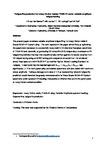Fatigue life prediction for rotary friction welded Ti-6Al-4V under variable amplitude fatigue loading
| dc.contributor.author | van der Merwe, HB | en |
| dc.contributor.author | James, MN | en |
| dc.contributor.author | Hattingh, DG | en |
| dc.contributor.author | Rall, W | en |
| dc.date.accessioned | 2019-10-31T15:36:00Z | |
| dc.date.available | 2019-10-31T15:36:00Z | |
| dc.date.issued | 2019-12 | en |
| dc.identifier.issn | 0167-8442 | en |
| dc.identifier.other | 102321 | en |
| dc.identifier.uri | http://hdl.handle.net/10026.1/15100 | |
| dc.description.abstract |
The present paper considers variable amplitude fatigue lifing for rotary friction welds in Grade 23 6Al-4V titanium alloy. The work reported in this paper aimed firstly at optimising the parameters necessary to successfully rotary weld 6 mm diameter hourglass specimens of Ti-6Al-4V and, secondly, at generating CA stress-life (S-N) fatigue data to underpin a VA fatigue life prediction that was then experimentally verified against the results obtained from VA fatigue testing using an 3200 turning point sequence extracted from the simulated aircraft load spectrum mini-FALSTAFF (a modified Fighter Aircraft Loading Standard for Fatigue). It was found that the real damage sum Dreal=(Dspec/Ls)*N‾exp was significantly <1.0 for both parent alloy and welded specimens and also varied with maximum stress amplitude. Taking a damage sum value of 1.0 as representing failure in fatigue life prediction would therefore be grossly nonconservative for these Grade 23 6Al-4V titanium specimens under spectrum VA loading, irrespective of whether they are in the parent plate or rotary friction welded condition. | |
| dc.format.extent | 102321 - 102321 | en |
| dc.language | en | en |
| dc.language.iso | en | en |
| dc.publisher | Elsevier | en |
| dc.title | Fatigue life prediction for rotary friction welded Ti-6Al-4V under variable amplitude fatigue loading | en |
| dc.type | Journal Article | |
| plymouth.volume | 104 | en |
| plymouth.journal | Theoretical and Applied Fracture Mechanics | en |
| dc.identifier.doi | 10.1016/j.tafmec.2019.102321 | en |
| plymouth.organisational-group | /Plymouth | |
| plymouth.organisational-group | /Plymouth/Faculty of Science and Engineering | |
| plymouth.organisational-group | /Plymouth/Faculty of Science and Engineering/School of Engineering, Computing and Mathematics | |
| plymouth.organisational-group | /Plymouth/Users by role | |
| plymouth.organisational-group | /Plymouth/Users by role/Academics | |
| dcterms.dateAccepted | 2019-07-27 | en |
| dc.rights.embargodate | 2020-08-01 | en |
| dc.rights.embargoperiod | Not known | en |
| rioxxterms.versionofrecord | 10.1016/j.tafmec.2019.102321 | en |
| rioxxterms.licenseref.uri | http://www.rioxx.net/licenses/all-rights-reserved | en |
| rioxxterms.licenseref.startdate | 2019-12 | en |
| rioxxterms.type | Journal Article/Review | en |


